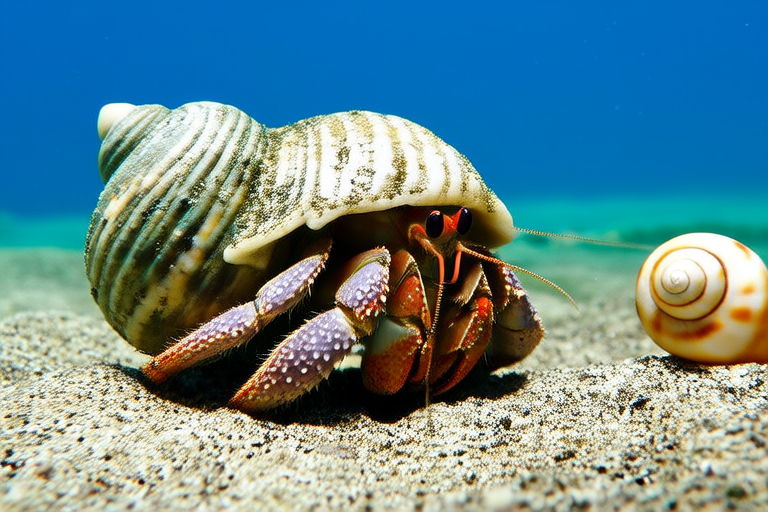The Unique Shell-Swapping Behavior of Hermit Crabs
Hermit crabs are fascinating creatures that have adapted an extraordinary way of protecting themselves – by utilizing discarded mollusk shells as their homes. This shell-swapping behavior is not just a simple act of moving into a new house; it’s a complex process influenced by various factors that ensure their survival and adaptation. Let’s delve into the intricate details of this behavior, its significance, and the scientific insights behind it.
The Process of Shell Swapping
The shell-swapping process begins when a hermit crab outgrows its current shell or finds one that better suits its needs. First, the crab positions itself near the opening of the new shell while still holding onto its old one. It then uses its front claws to grip the edge of the new shell and pull itself inside. Once comfortably situated, the crab will test the fit by moving around inside. If satisfied, it discards the old shell and makes the new one its permanent home.
Reasons for Changing Shells
Hermit crabs change shells for several reasons, primarily due to growth. As they grow larger, their existing shells become too small, necessitating a move to a bigger one. Additionally, damaged or deteriorating shells may force a crab to seek a new dwelling. Another reason could be the discovery of a more suitable shell with better protection or improved mobility.
Social Aspects During the Swap
Shell swapping often involves social interactions among hermit crabs. These interactions can be quite competitive, with multiple crabs vying for the same shell. When a suitable shell becomes available, a group of crabs may gather around it, forming a ‘shell train.’ The largest crab moves first into the new shell, followed by progressively smaller crabs taking up the vacated ones. This chain reaction ensures that each crab ends up with a shell that fits better than before.
Environmental Factors Influencing Their Choices
The availability of suitable shells in the environment plays a critical role in the shell-swapping behavior of hermit crabs. Studies have shown that hermit crabs prefer shells that match their body size and shape closely. They also consider the thickness and durability of the shell, which provides better protection against predators. Environmental conditions such as wave action and substrate type can affect the distribution of available shells, thereby influencing the crab’s choice.
Peculiar Rituals Observed
During shell swapping, some peculiar rituals have been observed. For instance, hermit crabs have been seen engaging in ‘shell fights,’ where two crabs compete aggressively over a desirable shell. These fights can involve biting, clawing, and even flipping opponents over. Despite these intense competitions, there are instances where crabs engage in cooperative behaviors, sharing information about shell quality or helping each other find suitable replacements.
Scientific Insights and Observations
Research has provided valuable insights into hermit crab shell selection and competition. Scientists have found that hermit crabs use chemical cues to assess the suitability of a shell. They release pheromones that signal their presence and readiness to swap. Moreover, studies have demonstrated that crabs can recognize and remember the owners of specific shells, avoiding those that belong to rivals.
Crucial for Survival and Adaptation
The shell-swapping behavior is crucial for the survival and adaptation of hermit crabs. By continuously upgrading their protective coverings, they enhance their chances of evading predators and thriving in their environment. Adequate shell supply in their habitats is essential for their well-being. Without enough suitable shells, hermit crabs may face increased predation risk, stunted growth, and reproductive failure.
Importance of Adequate Shell Supply
An abundant supply of appropriate shells is vital for the health and prosperity of hermit crab populations. Insufficient shell availability can lead to overcrowding, increased competition, and stress among crabs. This scarcity can disrupt the natural balance of their ecosystems, affecting not only hermit crabs but also other marine species that depend on them.
In conclusion, the shell-swapping behavior of hermit crabs is a remarkable example of adaptation and resource management in the animal kingdom. Understanding this behavior and ensuring the preservation of their habitats are key steps towards safeguarding these intriguing creatures and the diverse marine environments they inhabit.
